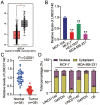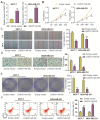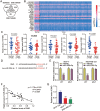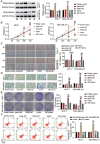LINC01140 Hinders the Development of Breast Cancer Through Targeting miR-200b-3p to Downregulate DMD
- PMID: 38009192
- PMCID: PMC10683380
- DOI: 10.1177/09636897231211202
LINC01140 Hinders the Development of Breast Cancer Through Targeting miR-200b-3p to Downregulate DMD
Abstract
Long non-coding RNAs (lncRNAs) are frequently reported to be involved in breast cancer (BC) oncogenicity. The goal of this study was to probe lncRNA LINC01140's role and action mechanism in BC. Relative LINC01140, miR-200b-3p, and dystrophin (DMD) levels were determined using quantitative real-time polymerase chain reaction (qRT-PCR). DMD protein levels in BC cells were quantified using Western blotting, and the targeting relationships were validated by luciferase reporter assays and RNA immunoprecipitation experiments. The proliferative potential of the cells was evaluated using CCK-8 and colony formation tests, while the migratory and invasive abilities of the cells were assessed using scratch and transwell assays. Apoptosis was assessed by flow cytometry. Nude mouse models have been established to allow the examination of tumor growth in vivo. Pronounced downregulation of LINC01140 and DMD, as well as upregulation of miR-200b-3p, was observed in BC. LINC01140 binds directly to miR-200b-3p to downregulate DMD expression. Ectopic LINC01140 expression not only limited tumor growth in vivo but also diminished the proliferation, migration, and invasion abilities of BC cells in vitro, however, it induced apoptosis in BC cells. Elevated miR-200b-3p expression stimulated the tumorigenic potential of BC cells and attenuated the suppressive effect of LINC01140 or DMD overexpression on BC cell malignancy, whereas DMD overexpression restricted the tumorigenic potential of BC cells. Overall, LINC01140 prevents BC development via the miR-200b-3p-DMD axis. These findings support the latent potential and usefulness of the LINC01140-miR-200b-3p-DMD network as a target for BC therapy.
Keywords: DMD; LINC01140; breast cancer; lncRNA; miR-200b-3p.
Conflict of interest statement
Declaration of Conflicting InterestsThe author(s) declared no potential conflicts of interest with respect to the research, authorship, and/or publication of this article.
Figures







Similar articles
-
Circ_0,007,331 Promotes the PTX Resistance and Progression of Breast Cancer via miR-200b-3p/ANLN.J Surg Res. 2022 Nov;279:619-632. doi: 10.1016/j.jss.2022.05.004. Epub 2022 Aug 1. J Surg Res. 2022. PMID: 35926312
-
LINC01140 Targeting miR-452-5p/RGS2 Pathway to Attenuate Breast Cancer Tumorigenesis.Dis Markers. 2022 Oct 17;2022:2434938. doi: 10.1155/2022/2434938. eCollection 2022. Dis Markers. 2022. PMID: 36299824 Free PMC article.
-
MicroRNA-200b-3p restrains gastric cancer cell proliferation, migration, and invasion via C-X-C motif chemokine ligand 12/CXC chemokine receptor 7 axis.Bioengineered. 2022 Mar;13(3):6509-6520. doi: 10.1080/21655979.2022.2034585. Bioengineered. 2022. PMID: 35226830 Free PMC article.
-
Exosome-Mediated lncRNA LINC01140 Attenuates Breast Cancer Progression by Regulating the Wnt/β-Catenin Pathway.Crit Rev Eukaryot Gene Expr. 2023;33(7):31-42. doi: 10.1615/CritRevEukaryotGeneExpr.2023048344. Crit Rev Eukaryot Gene Expr. 2023. PMID: 37602451
-
LINC00667 Promotes Progression of Esophageal Cancer Cells by Regulating miR-200b-3p/SLC2A3 Axis.Dig Dis Sci. 2022 Jul;67(7):2936-2947. doi: 10.1007/s10620-021-07145-5. Epub 2021 Jul 27. Dig Dis Sci. 2022. PMID: 34313922
Cited by
-
Transcriptomic analysis reveals regulation of adipogenesis via long non-coding RNA, alternative splicing, and alternative polyadenylation.Sci Rep. 2024 Jul 23;14(1):16964. doi: 10.1038/s41598-024-67648-9. Sci Rep. 2024. PMID: 39043790 Free PMC article.
-
Identification and validation of monocyte to macrophage differentiation-associated as a prognostic biomarker in gastric cancer.Front Oncol. 2025 Apr 16;15:1508355. doi: 10.3389/fonc.2025.1508355. eCollection 2025. Front Oncol. 2025. PMID: 40308510 Free PMC article.
References
-
- Rossi S, Schinzari G, Basso M, Strippoli A, Dadduzio V, D’Argento E, Cassano A, Barone C. Maintenance hormonal and chemotherapy treatment in metastatic breast cancer: a systematic review. Future Oncol. 2016;12(10):1299–307. - PubMed
-
- Fitzmaurice C, Allen C, Barber RM, Barregard L, Bhutta ZA, Brenner H, Dicker DJ, Chimed-Orchir O, Dandona R, Dandona L, Fleming T, et al.. Global, regional, and national cancer incidence, mortality, years of life lost, years lived with disability, and disability-adjusted life-years for 32 cancer groups,1990 to 2015: a systematic analysis for the Global Burden of Disease Study. JAMA Oncol. 2017;3(4):524–48. - PMC - PubMed
-
- Siegel R, Ma J, Zou Z, Jemal A. Cancer statistics, 2014. CA Cancer J Clin. 2014;64(1):9–29. - PubMed
-
- Siegel RL, Miller KD, Jemal A. Cancer statistics, 2018. CA Cancer J Clin. 2018;68(1):7–30. - PubMed
Publication types
MeSH terms
Substances
LinkOut - more resources
Full Text Sources
Medical

